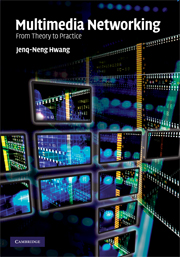Book contents
- Frontmatter
- Contents
- Preface
- Acknowledgements
- List of abbreviations
- 1 Introduction to multimedia networking
- 2 Digital speech coding
- 3 Digital audio coding
- 4 Digital image coding
- 5 Digital video coding
- 6 Digital multimedia broadcasting
- 7 Multimedia quality of service of IP networks
- 8 Quality of service issues in streaming architectures
- 9 Wireless broadband and quality of service
- 10 Multimedia over wireless broadband
- 11 Digital rights management of multimedia
- 12 Implementations of multimedia networking
- Index
4 - Digital image coding
Published online by Cambridge University Press: 26 January 2010
- Frontmatter
- Contents
- Preface
- Acknowledgements
- List of abbreviations
- 1 Introduction to multimedia networking
- 2 Digital speech coding
- 3 Digital audio coding
- 4 Digital image coding
- 5 Digital video coding
- 6 Digital multimedia broadcasting
- 7 Multimedia quality of service of IP networks
- 8 Quality of service issues in streaming architectures
- 9 Wireless broadband and quality of service
- 10 Multimedia over wireless broadband
- 11 Digital rights management of multimedia
- 12 Implementations of multimedia networking
- Index
Summary
Image compression is the application of data compression techniques to two-dimensional digital images I(x, y), to reduce the redundancy of the image data for storage or transmission in an efficient form. Image compression can be classified into two categories: lossless or lossy. Lossless compression, which achieves smaller compression ratios than lossy compression, mainly takes advantage of the image contents containing a non uniform probability distribution for a variable-length representation of the image pixels. Such images include technical drawings, icons or comics, and high-value contents such as medical imagery or image scans made for archival purposes. However, lossy compression methods, especially when they achieve a very high compression ratio, can introduce compression artifacts. Nevertheless, lossy compressions are especially suitable for natural images, such as photos, in applications where a minor (sometimes imperceptible) loss of fidelity is acceptable when it is desirable to achieve a substantial reduction in bitrate. Most of the stateof-the-art image compression standards use a combination of lossy and lossless algorithms to achieve the best performance.
The Joint Photographic Experts Group (JPEG) [1], a discrete cosine transform(DCT)-based technique, is the most widely used standardized lossy image compression mechanism; it was designed for compressing either full-color or gray-scale images of natural, real-world, scenes. It works well for photographs, naturalistic artwork and similar material if the compression ratio is about 20 : 1, which is much better than the 4 : 1 compression ratio provided by a lossless compression method such as the Graphics Interchange Format (GIF) [2]. However, it does not work so well for lettering, simple cartoons, or line drawings.
- Type
- Chapter
- Information
- Multimedia NetworkingFrom Theory to Practice, pp. 62 - 106Publisher: Cambridge University PressPrint publication year: 2009



